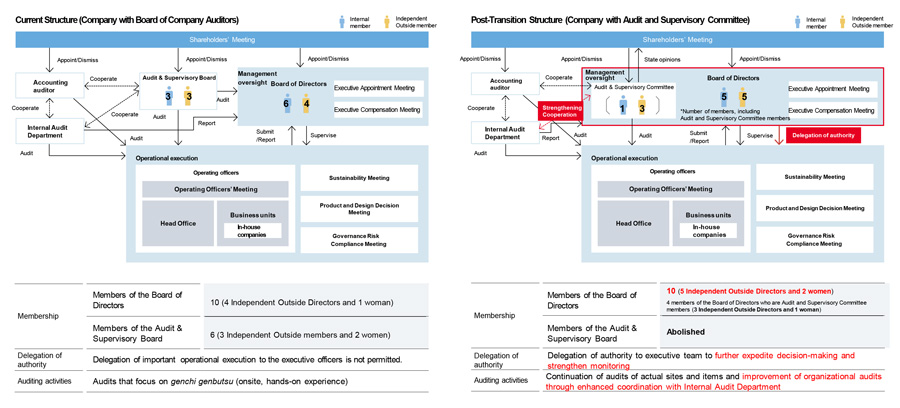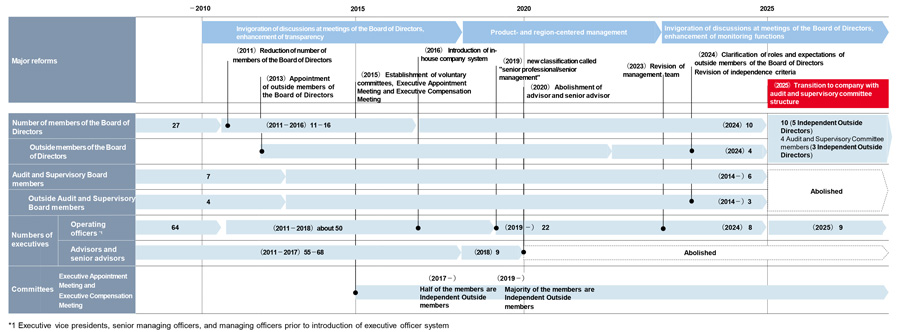At the Board of Directors meeting held today, Toyota Motor Corporation (“TMC”) resolved to transition from a company with an Audit and Supervisory Board to a company with an Audit and Supervisory Committee, following approval at the 121st Ordinary General Meeting of Shareholders to be held in June 2025.
As a result of this transition, Toyota will establish the role of Members of the Board of Directors serving as the Audit and Supervisory Committee Members, who will maintain voting rights in the Board of Directors. In addition, Independent Outside Directors will comprise five out of the total ten directors―fully half of the board―and three of the four Members of the Board of Directors serving as the Audit and Supervisory Committee Members. To transform into a mobility company, Toyota seeks to reinvigorate the Board of Directors through a combination of Directors who practice management based on products and regions, and Independent Outside Directors who can provide advice from a wider perspective.
Toyota believes that in order to remain a company that is always chosen by stakeholders, it needs a Board of Directors that maximizes the knowledge and expertise of its directors and contributes to growth along with all the stakeholders supporting the automotive industry as it moves towards the future we hope to create. With this transition, all members of the Board of Directors may join discussions without constraint based on inside/outside roles or titles. This will encourage full participation and reinvigorate the Board. Additionally, Toyota will promote faster decision-making by delegating authority to executive management and strengthen the monitoring functions of the Board of Directors.
Since its establishment, Toyota’s founders pushed toward creating domestic automobiles and built the foundations of Japan’s automobile industry together with its suppliers and dealers. The spirit of “working for the sake of others” and “making others’ work easier” has led to research and development ahead of the times to improve people’s lives and society, which is the core of the Toyota way.
Based on that, Toyota has transformed its way of working and organizational structure. With the axes of “making ever-better cars” and being the “best-in-town,” each person working on the frontlines has thought and acted independently towards autonomous growth and long-term corporate value enhancement.
To establish a corporate governance system, Toyota has reviewed the number of directors and officers and abolished the advisor system to speed up decision-making and promote the appointment of diverse human resources.
1) Revitalization of Board of Directors
- In 2011, the number of directors was streamlined from 27 to 11 (currently 10)
- In 2013, appointed Outside Directors (currently 40%, 4 out of 10)
- Outside Directors include diverse individuals with a balanced skill set
- Outside Directors provide valuable advice based on their broad and extensive experience and insights, independent of business execution during Toyota’s management decision-making process. Additionally, to enhance the board effectiveness, it carries out annual analyses and evaluations of the board and then enacts improvements.
2) Management based on products and regions
- In 2016, the in-house company system was introduced
- Toyota changed its structure so that each in-house company president is responsible for everything from vehicle planning to production within their company.
- In 2019, Toyota introduced the “senior professional/senior management (kanbushoku in Japanese)” system, shifting from a title-based to a role-based personnel system. In following, Toyota has continued to review titles such as Vice President and Operating Officer.
Structure after transition (Company with Audit and Supervisory Committee)
| Title | Name | Category |
|---|---|---|
| Representative Director, Chairman of the Board of Directors | Akio Toyoda | |
| Representative Director, President | Koji Sato | |
| Representative Director, Vice President | Hiroki Nakajima | |
| Yoichi Miyazaki | ||
| Director | Shigeaki Okamoto [Newly appointed] | Outside |
| Kumi Fujisawa [Newly appointed] | Outside | |
| Director who is a member of the Audit and Supervisory Committee | C. P. Reynolds [Newly appointed] | Inside |
| George Olcott [Newly appointed]
Changed from Auditor
|
Outside | |
| Masahiko Oshima [Newly appointed]
Changed from Director
|
Outside | |
| Hiromi Osada [Newly appointed]
Full-time
Changed from Auditor
|
Outside |
(Note) The selection of the Representative Directors and Executive Directors will be formally conducted at the Board of Directors meeting following the 121st Ordinary General Meeting of Shareholders scheduled to be held in June 2025.
In an era of rapid change and uncertainty, Toyota intends to strengthen monitoring functions and delegate authority to the executive management, while making swift decisions that resonate with society. We will continue to flexibly review our internal decision-making bodies, including the Board of Directors, to adapt to the times.
Key Points of Transition to a Company with an Audit and Supervisory Committee
The Board of Directors, composed of Internal and Outside members, will make decisions and supervise without being constrained by titles, promoting further revitalization of the Board.
- As a Company with an Audit and Supervisory Committee, Toyota will establish an Audit and Supervisory Committee, consisting of some members of the Board of Directors.
- Audit and Supervisory Committee members will participate in Board discussions as directors with voting rights, in addition to their role of auditing the execution of directors’ duties and supervising the appropriateness of business execution.
- With this transition, it will be possible to delegate important business execution decisions from the Board of Directors to the executive side, speeding up decision-making and allowing the Board to focus on supervisory duties.

Changes in Governance Structure

SOURCE: Toyota
